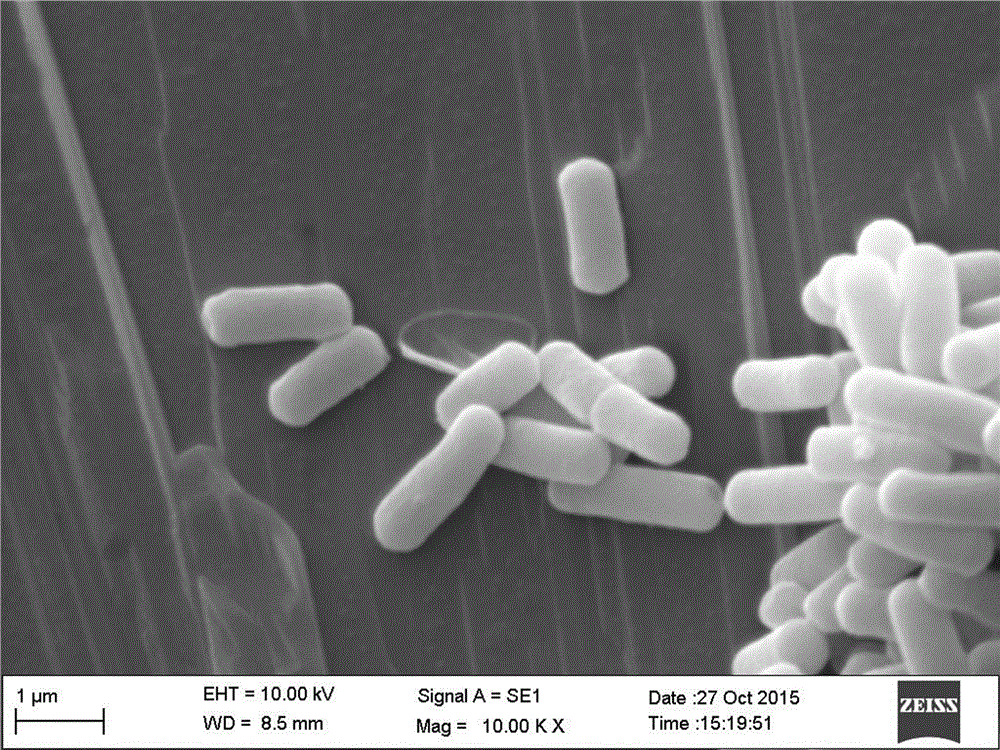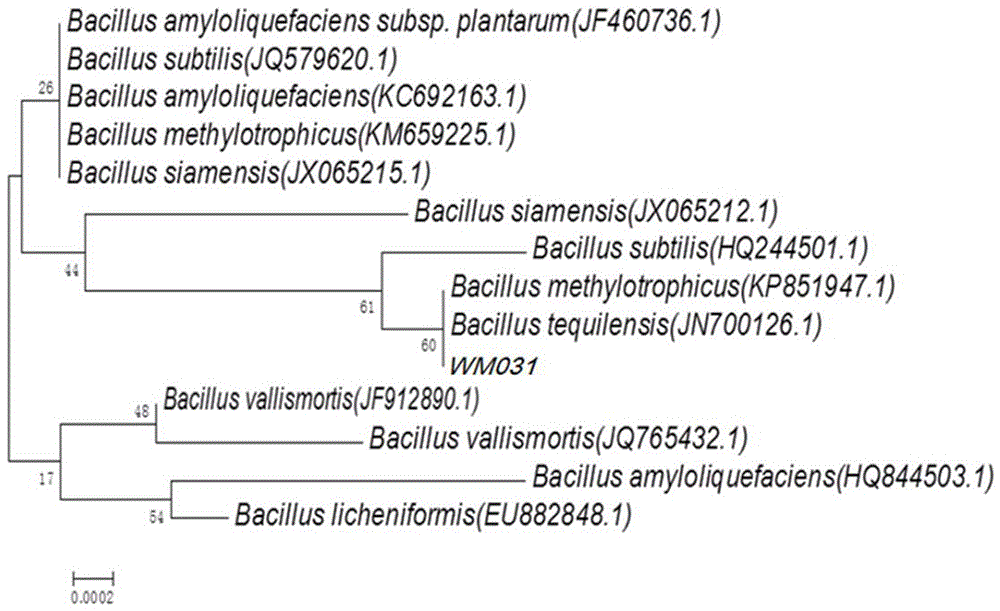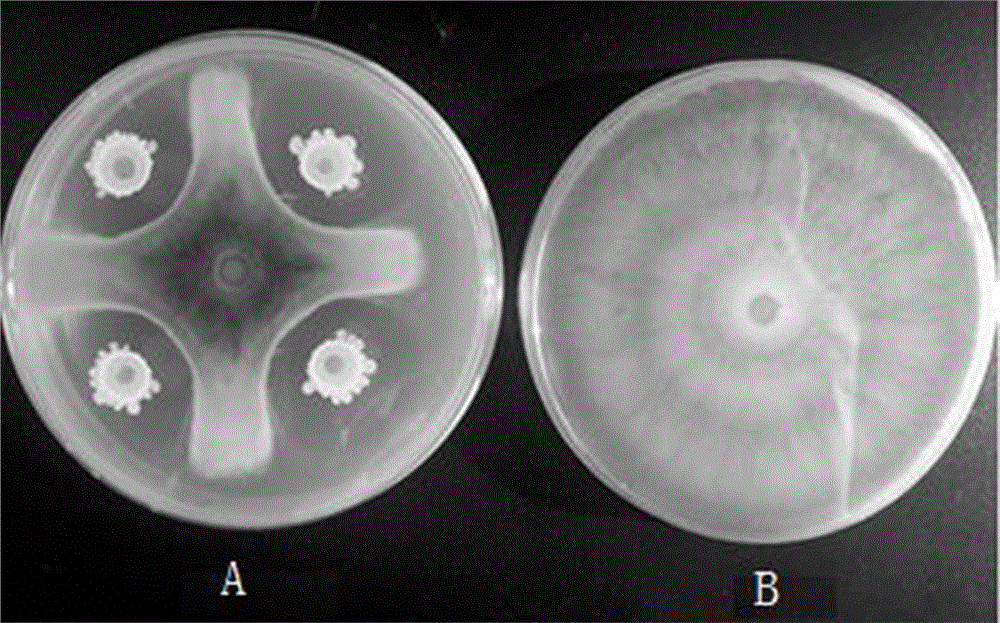Tequila bacillus and application thereof
A technology of bacillus and bacterial liquid, applied in the application, bacteria, fungicides and other directions, can solve the problem that the biocontrol effect of watermelon fusarium wilt has not been reported.
- Summary
- Abstract
- Description
- Claims
- Application Information
AI Technical Summary
Problems solved by technology
Method used
Image
Examples
Embodiment 1
[0030] The acquisition of embodiment 1 bacterial strain and the preparation of bacterial liquid
[0031] 1. Obtaining the strain
[0032] (1) Sample collection: collect an appropriate amount of fresh plant samples from the roots of tomato plants in the vegetable base of Jiangsu Academy of Agricultural Sciences, Nanjing City, Jiangsu Province, rinse the dust and soil on the surface with tap water, dry naturally, and then sterilize the surface of the plant root tissue : Then soak in 75% alcohol for 1min and 8%NaClO for 4min in turn for surface disinfection treatment, and wash with sterile water for 4 times;
[0033] (2) Separation and screening: Cut the roots, stems and leaves with sterile scissors, cut the roots and stems into small pieces of about 1 cm, and place them on the LB plate; add water to the root and grind it into a paste, put it on the LB plate after standing for 10 minutes, and place it on the LB plate Incubate at 30°C for 48h;
[0034] (3) Purification: After th...
Embodiment 2
[0046] The inhibitory effect of embodiment 2 bacterial strain WM031 to watermelon Fusarium wilt
[0047] (1) Inoculate the watermelon Fusarium wilt bacteria on the PDA plate, cultivate the plate at 28°C, and then use a puncher with a diameter of 5mm to make a fungus cake. Spot WM031 bacterial solution (concentration 10 8 cfu / mL, 100 μL) The WM031 bacterial solution obtained in Example 1 was used as the experimental group, and the plate only inoculated with pathogenic fungi was used as the control, and each treatment was repeated 3 times;
[0048] (2) Place the PDA plate at 28°C for 7 days, wait until the pathogenic fungal colonies in the control group cover the plate, measure the diameter of the pathogenic fungal colony, and calculate the antibacterial rate according to the following formula:
[0049] Bacterial inhibition rate (%)=[(A-B) / (A-5)]*100%;
[0050] (Note: A is the diameter of the pathogenic fungal colony in the control group, B is the diameter of the pathogenic fu...
Embodiment 3
[0052] The colonization of embodiment 3 bacterial strain WM031 in soil and watermelon plant
[0053] Add 1 μg / mL rifampicin to the LB plate, then insert the WM031 strain obtained in Example 1, gradually increase the concentration of rifampicin to 300 μg / mL, and screen out mutants that can grow stably and have the same physiological characteristics as the original strain Bacterial strains: transfer 10 generations on LB plates, observe the colony morphology, and then transfer to LB medium added with 300 μg / mL rifampicin for labeling.
[0054] 1. WM031 colonization in soil
[0055] (1) Inoculate the strain WM031 labeled with 300 μg / mL rifampicin into LB culture medium, shake at 32°C, 180 r / min, and shake for 24 hours to make a bacterial content of about 10 8 cfu / mL marker strain bacterial suspension;
[0056] (2) Put the natural soil (taken from Nanjing, the experimental field of Jiangsu Academy of Agricultural Sciences) and sterilized soil in flowerpots, 1kg of soil in each po...
PUM
| Property | Measurement | Unit |
|---|---|---|
| diameter | aaaaa | aaaaa |
Abstract
Description
Claims
Application Information
 Login to View More
Login to View More - R&D
- Intellectual Property
- Life Sciences
- Materials
- Tech Scout
- Unparalleled Data Quality
- Higher Quality Content
- 60% Fewer Hallucinations
Browse by: Latest US Patents, China's latest patents, Technical Efficacy Thesaurus, Application Domain, Technology Topic, Popular Technical Reports.
© 2025 PatSnap. All rights reserved.Legal|Privacy policy|Modern Slavery Act Transparency Statement|Sitemap|About US| Contact US: help@patsnap.com



